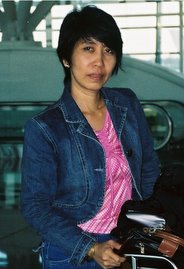
Why My Passion for This Theater
by Marilie Fernandez-Ilagan
One afternoon, on my way home from school, I was attracted by the noise coming from the church by the sea. I went in and saw David, a well-liked gay church worker in our small town of
It took all of seven years before I found myself performing onstage – in high school dramatics. In college at the Ateneo de Davao, I was expectedly also active in theater. Later, I joined a theater group of a social development agency. It seemed like there was no turning back.
Then one day, in 1982, I learned a man was arrested by the police. He was unlike most captives. He stood proud. It was Karl Gaspar becoming a political prisoner.
In the 1980s in
Instead of running away from theater on account of Karl’s arrest, I kept my faith. At that time, I was already active in Kulturang Atin Foundation, Inc. (Kafi), a big name in the mass-based cultural work in
I also became active in the Mindanao Community Theater Network (MCTN), an impressive theater coalition in the island, whose cultural workers and popular educators had a favorite slogan: “Magkoryo tayo kung paano mag-akyo” (Let’s do plays, songs and dances the way we use acupuncture),” in the sense of “healing our social ills.” MCTN explored and mastered cultural action programs in the communities, combining education processes with advocacy work through theater. My work in these organizations taught me theater’s relevance to the day-to-day life of the people to survive and find meaning in their poverty and misery.
This is not to say that my college learning of Western classical theater did not amount to something. In fact, I was glad that I had a taste of the
My theater since the 1980s, however, concentrated on folk traditions -- particularly on indigenous forms, and women’s issues. I chose to focus on these because I wanted to catch up with my appreciation of my indigenous roots at the same time that I was being stirred up by the women’s liberation movement.
My passion for this kind of theater was all the more encouraged when in 1990, my colleagues and I in the Kaliwat Theater Collective interacted with Dr. Julie Holledge, chair of the drama center of
My interactions and immersions with the virtuosos of the indigenous communities of
All told, I found challenge and freedom as I grew up in the Mindanaoan theater. Perhaps because theatre -- the way we define it in
When some say that theater using indigenous forms and tackling women’s issues has remained largely on the fringe, I become impassioned about my desire for this kind of theater to break through the barrier of the experimental. Also, I wish to show that theater could both be art form and platform. Politics needs the theater as much as the theater needs politics. As long as I live it, as long as I am clear about my development as a theater artist through reflection, self-discovery and assertion, I’d be impassioned about this kind of theater that serves beyond the entertainment.

No comments:
Post a Comment